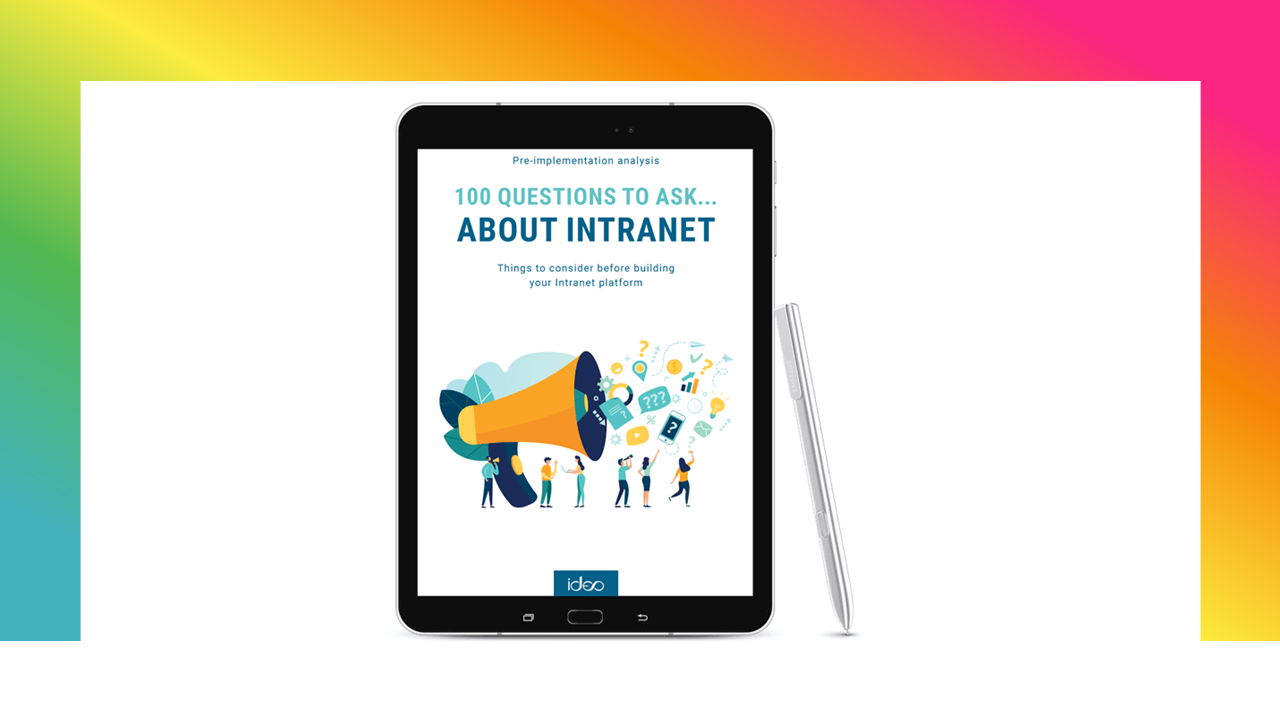

Internal Communications experts from Ideo Software House prepared an interactive PDF entitled ‘Brief for a good intranet’. It can help you with getting through the intranet analysis and design stage. To ease your work, Urszula Kandefer, IC expert at Ideo, prepared a set of questions that can also serve as an introduction to pre-implementation analysis. It aims to draw your attention to aspects not obvious and hence we forget about them. Thank you Urszula!

Urszula Kandefer, IC expert at Ideo Software House (LinkedIn)
Urszula divided it into sections to organise crucial intranet thematic areas. Each has a brief commentary along with practical questions. They are to encourage you to reflect on your expectations towards the IT implementation. Check out the first two chapters below and download a PDF file with all questions prepared by Ideo.
Things to consider before building your intranet project
The intranet offers you a wide range of opportunities, while its proper implementation is a significant step for your business development. It streamlines, shortens many processes for employees. Once they've used the intranet, they cannot imagine their daily work without it.
Designing an intranet system is a complicated process. When making such a decision, the entire implementation should be analysed and planned in detail. It allows you to avoid mistakes and makes it easier to achieve the desired effect.
I. CHOOSING THE IT SUPPLIER
If you want to commission an intranet platform, remember to define the criteria for cooperation between your company and the IT supplier.
Review the company's expertise in intranet design, the number of projects they have completed, and any references from business partners. You can find information about it on their website often, as online portfolios with descriptions. Application service providers (ASPs) publish case studies often called customer stories. Many show the before-after effect. Look for any statistics, infographics, or charts as they can give you an idea about how the intranet implemented affected a company.
To check the IT supplier's reputation, research their website in-depth for any current customers' reviews or references. Find proof the company is an expert. Any awards received individually or granted to their customers bode well. Also, if they create valuable publications, they must have the experience to do so. Any engagement in the knowledge-sharing process is a good omen they will do that with you.
It is worthwhile to know the provider's full offer. For instance, what technologies they apply, hosting options available, guarantees, post-implementation, and technical support. These aspects determine whether the company keeps up with IT development and if they approach their customer's challenges head-on.
Find out if the company's expertise lies in one-off implementations or prefers permanent cooperation with the Client. Check what's their usual tenor of cooperation, what happens once the projects are complete, and how the company approaches the after-sales support.
Ask yourself the following questions:
1. How long has the company been on the market? What experience does it have in building intranets? Do they display projects' portfolios on their website? Which companies have benefited from its services? Are these companies similar (size, number of branches, industry) to yours?
2. Can you get any detailed project descriptions?
3. What project reviews can you find on rating portals, websites, or elsewhere?
4. Has the company received any awards for completing any projects? What awards?
5. Has the company implemented any projects outside the domestic market?
6. Do you have the possibility to get familiar with reference letters from clients?
7. Is this possible for you to converse directly with the company's customers?
8. What technologies they have used in projects they have worked on? Does the company offer any explanation or case studies on why they recommended the solutions?
9. Does the company produce valuable publications that offer guidance and can help you answer your questions?
10. What methodologies are used to create and manage projects?
11. What security mechanisms and standards does the supplier mention? What security measures does it offer?
12. Does the company describe many security mechanisms and standards? What are these mechanisms?
13. Will you be able to count on a dedicated project supervisor when choosing this company?
14. What is the warranty period offered by the company and under what conditions? What additional services can you embrace when choosing the particular supplier?
15. Does the company offer, e.g., various hosting options to maintain the intranet? What are the recommended solutions?
16. What are the conditions for providing technical support? What does it look like, incl. problem response time, incident reporting, and what services the companies include in the business offer?
17. Does the company use only its resources? Are the projects implemented comprehensively?
18. Does the company specialize only in implementations, or does it have a comprehensive view of Intranet issues and internal communications? Can you count on consulting in business and marketing regarding internal communication as part of cooperation?
19. Does the company work with anyone externally, intranet experts, or any internal communication specialists?
20. Can you count on any support in analyzing your company's needs?
21. Will you get a system matching specific requirements? Will you be able to adapt it to your specific needs and processes in your company?
II. THE INTRANET USERS' NEEDS
The intranet's platform success largely depends on adapting it to the needs of organizations and employees who use its features in their daily work. Depending on the specifics of the business, the company's organizational structure, users, and the nature of their work, you will see vast differences in this scope.
A company specializing in heavy industry will require other tools than you can find, for example, in a financial organization. Think about devices your employees will access the intranet: a desktop computer, portable computer, or smartphone are now standard. With, for example, production companies, it may also be necessary to have a multimedia kiosk, a public monitor displaying selected data, etc. It is also important to determine whether each employee will log into the new intranet and whether they will use an individual account, or, e.g., an affiliate.
Then, it is worth inspecting your organizational structure much closer. The division into departments is an absolute minimum. We need to base all subsequent activities related to the determination of needs on the creation of a more detailed diagram based on the existing company structure. When designing the intranet, it is also important to consider the company's hierarchy, and most of all, to define the data source based on what you include in the intranet. The next step is to identify the information needs. First for general departments, and then for the tasks performed by these employees. Employee tasks differ at the department level, but also in terms of job titles.
Then, think about these tasks and how the intranet features you designed will support employees. What employee departments will it help the most in their daily work? Will it optimize the time they spend on tasks or reduce their number? How will know if you've achieved your goal? You can start with the problem, break it down into parts, set its priority, and cost justification for the organization. The idea is to get a complete picture, how many steps there are in a process and then arrange the sequence. Then, it is possible to design a process and its partial or complete automation.
Once you sketch these dependencies, you will see not just issues, but needs that introduced will improve the overall company workflow. After the initial internal evaluation of the company, it is worth reaching for the opinion of an internal communication specialist. Many times, the view of an experienced third party allows you to verify, organize or simplify many processes and, thus, meet the needs of employees more efficiently.
We also encourage you to download our intranet brief, where you will find many fresh and practical ideas for designing your brand-new intranet.
Ask yourself the following questions:
22. What is the organizational company structure? What departments are there?
23. Is it possible to prepare employee surveys or meetings with employees from various departments? If you can't ask everyone, choose 3 employees from each department, and meet them. Are you able to find at least 3 problems or needs that are worth considering in the planned intranet?
24. What should be done and what tools are needed to solve the problem?
25. How does this problem affect the business process? List the pros and cons.
26. Is the problem repeatable?
27. How can you get a reply from potential intranet users?
28. How will the collected information be analyzed and who will be responsible for this task?
29. Will there be special templates for statements sent in the form of a file, online surveys?
30. Will integration with communication or collaboration tools be required?
31. What will the cooperation between the IT department and the implementation team look like?
32. Should the intranet contain elements typical for social media portals (photo and video galleries, the possibility of commenting, rating, and publishing posts by employees)?
33. Will the platform include functions such as task management, document sharing, and time tracking for individual tasks?
34. Should KPI dashboards be an integral part of the intranet home screen? What other elements should be on the home page?
35. Will employees be able to personalize the screen and set widgets and shortcuts to the applications they need?
36. Will the intranet be integrated with other systems operating in the company? What kind and to what extent?
37. Will it require you to introduce features related to the HR and Finance departments? (holiday applications, timesheets, account settlements, etc.)
38. Is there a list of ideas for new intranet features that could be implemented in the future?
As you already know, the intranet offers a long list of new opportunities. It's up to you to decide which ones to take advantage of. Internal Communication experts from Ideo has prepared materials that will help you carry out the pre-implementation analysis.
As I wrote earlier - to make things easier, you can download this full list as a PDF as well: 100 Questions You Should Ask... About the Intranet
It will guide you, question by question, through the key areas that are worth considering at the needs analysis stage of a new intranet. Even if your organisation already has an intranet platform in place, it is worth considering how you can improve it.
Second file to download is an interactive Intranet Brief. It will help you think through your needs and expectations, and weigh what features your intranet has against what else you can add to it. This is not a simple form to fill out, but an interactive tool that supports teams in planning a modern intranet. To read more about this PDF tool you can also visit my blog post: Intranet 2021 - features to include in your intranet platform.
******
Join me on:
• Facebook @behindtheicscenes
• Twitter @maja_biernacka
• LinkedIn
Graphics: Ideo








